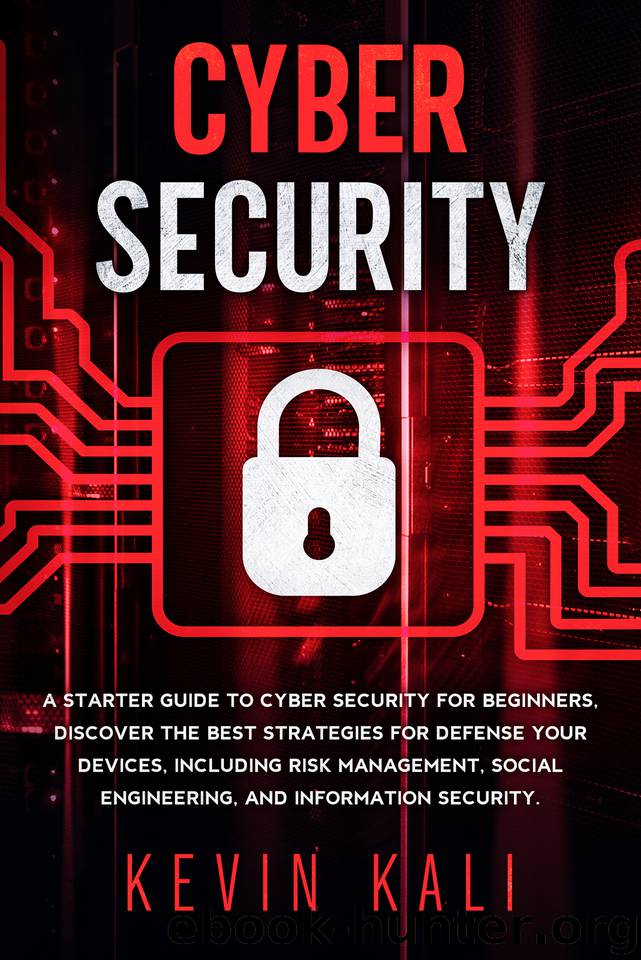Cyber Security: A Starter Guide to Cyber Security for Beginners, Discover the Best Strategies for Defense Your Devices, Including Risk Management, Social Engineering, and Information Security. by Kali Kevin

Author:Kali, Kevin [Kali, Kevin]
Language: eng
Format: epub
Published: 2019-11-15T16:00:00+00:00
Chapter 7
Preventing Cyber Attacks
In September 2014, Home Depot announced that it was hacked, probably during the spring of that year; this hack led to the theft of the credit card information of 56 million customers. The hack began when malware masquerading as antivirus software infected the POS systems of the company's stores. The company had to pay nearly twenty million dollars in damages and identity theft protection services to those whose information had been compromised.
In February 2015, the largest security breach in healthcare history occurred when a group of cyber criminals, allegedly sponsored by a foreign government, hacked into the Anthem Health Insurance website. The attack led to millions of names, addresses, dates of birth, and the personal health information of individuals insured by Anthem to become compromised. The breach began when an Anthem employee opened up a phishing email; that one email led to well over one hundred million dollars in damages.
In the fall of 2016, while Yahoo was in negotiations to sell itself to the company Verizon, it disclosed that back in 2014, it had been hacked. 500 million email addresses, real names, dates of birth, and other sensitive information that can lead to identity theft had all been hacked. In the early winter of 2016, it disclosed that it had also been similarly hacked back in 2013. This security breach led to compromising the information of one billion users. Yahoo lost $350 million in its sell price to Verizon, as well as its good name. There have been many more, many of which have not been in the news, since then.
Basic measures of protection include maintaining strong authentication practices (passwords, etc.) and not storing sensitive data where it is openly accessible, but a strong cybersecurity plan must also take into account that the digital world expands continually. The cloud, the use of personal devices at work, the growing internet of things (IoT, the inter-connection of home appliances, autos, digital devices, power plants and more)—all of these have created a need to keep up with progress, or even stay a step ahead of it.
The following areas of cybersecurity are key to the development of a strong strategy of protection. These aren’t the only vectors you need to be aware of, however, and the first line of defense against cybersecurity threats should always be a healthy dose of caution and common sense.
Critical infrastructure: Essential social services like electricity, water, traffic lights and medical facilities, when plugged into the Internet, become vulnerable to cyber-attacks. Those in responsible positions must detect, define and protect the weak points while everyone else should consider the effect an attack on the infrastructure would have on them and plan accordingly .
Network security: To protect against damaging intrusions—from both internal and external forces—it is often necessary to require extra log-ins or other measures which are not always completely effective and can also impact productivity. The data generated by these procedures presents another danger, that of missing critical alerts sometimes ‘lost in the crowd’ of data. Personnel
Download
This site does not store any files on its server. We only index and link to content provided by other sites. Please contact the content providers to delete copyright contents if any and email us, we'll remove relevant links or contents immediately.
Grails in Action by Glen Smith Peter Ledbrook(9163)
Sass and Compass in Action by Wynn Netherland Nathan Weizenbaum Chris Eppstein Brandon Mathis(8808)
Azure Containers Explained by Wesley Haakman & Richard Hooper(7444)
Configuring Windows Server Hybrid Advanced Services Exam Ref AZ-801 by Chris Gill(7433)
Kotlin in Action by Dmitry Jemerov(7263)
Running Windows Containers on AWS by Marcio Morales(6984)
Microsoft 365 Identity and Services Exam Guide MS-100 by Aaron Guilmette(5402)
Microsoft Cybersecurity Architect Exam Ref SC-100 by Dwayne Natwick(5212)
Combating Crime on the Dark Web by Nearchos Nearchou(4981)
The Ruby Workshop by Akshat Paul Peter Philips Dániel Szabó and Cheyne Wallace(4670)
Management Strategies for the Cloud Revolution: How Cloud Computing Is Transforming Business and Why You Can't Afford to Be Left Behind by Charles Babcock(4527)
Python for Security and Networking - Third Edition by José Manuel Ortega(4233)
The Age of Surveillance Capitalism by Shoshana Zuboff(4209)
Learn Wireshark by Lisa Bock(4119)
The Ultimate Docker Container Book by Schenker Gabriel N.;(3888)
Learn Windows PowerShell in a Month of Lunches by Don Jones(3681)
DevSecOps in Practice with VMware Tanzu by Parth Pandit & Robert Hardt(3568)
Windows Ransomware Detection and Protection by Marius Sandbu(3541)
Blockchain Basics by Daniel Drescher(3507)
